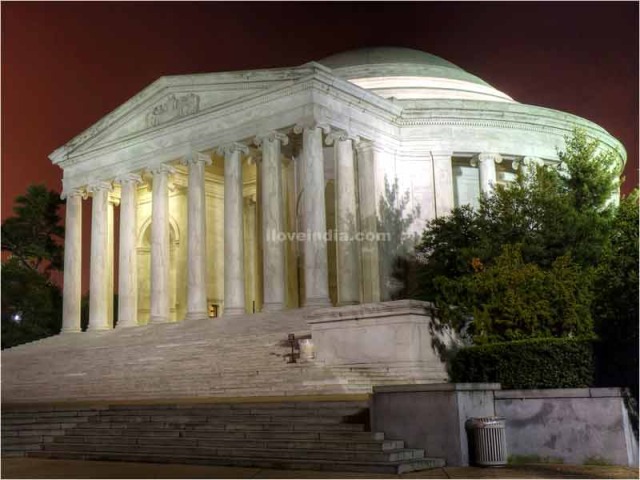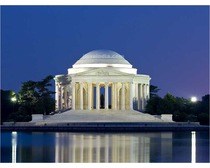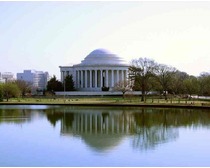Located in tidal basin near downtown Washington D.C, the Jefferson memorial symbolizes the guiding spirit of Thomas Jefferson. Read on to know interesting & fun facts about Jefferson Memorial.
Facts about Jefferson Memorial
Thomas Jefferson, the third President of the United States of America was a political philosopher, architect, diplomat, musician and scientist, who believed in the rights of man and a form of government derived from the people; who believed in freedom of religion and separation of church and state and in the concept of education for all. He is said to be one of the most enlightened men of the 18th century. As such, a memorial sited to pay tribute to his immense contribution and prominence to the making of United States was essential, which is why the Jefferson Memorial came up on the Tidal Basin, directly south of the White House, creating a monumental heart for the city of Washington D.C. Being a key landmark in the monumental core of the city, this memorial has been modeled after the Pantheon of Rome. This article has a bunch of trivia about this impressive architectural site. 

Interesting & Fun Facts About Jefferson Memorial
- Modeled after the Pantheon of Rome, Jefferson memorial is America's foremost memorial dedicated to the third president of US.
- The final design of the memorial project was submitted by an architect called John Russell Pope. Quite aptly, he chose a design that Thomas Jefferson had used while designing Monticello and the University of Virginia. Since Pope utilized Jefferson’s own idea, it was befitting to pay him a tribute by constructing his own memorial in the same fashion.
- There was controversy surrounding the selection of the design of the memorial. The Commission of Fine Arts objected to the Pantheon design because it would compete with the Lincoln Memorial. However, Roosevelt preferred the Pantheon design and gave his permission to proceed. The design was accepted in 1936, and on November 15, 1939, a ceremony was held in which President Roosevelt laid the cornerstone of the Memorial.
- The planning of the Jefferson memorial was quite a task. Several hindrances came in the way. The original architect of the project, Russell Pope had an untimely death, the Japanese chained themselves to the cherry trees in the area where the memorial was to be constructed during World War II and even four years after the monument was built and dedicated to Jefferson, his statue did not arrive.
- The present site where the Jefferson memorial is located was selected in 1937. The site was a cause of huge public criticism, since it resulted in the removal of the Japanese cherry trees in the Tidal Basin.
- Architects Daniel P. Higgins and Otto R. Eggers took over the construction of memorial upon the untimely death of Pope in August 1937.
- In 1941, Rudolph Evans was commissioned to sculpt the statue of Thomas Jefferson. The statue of Jefferson has been placed in a way that he looks out from the interior of the Memorial toward the White House. This was purposely done to represent the Age of Enlightenment and Jefferson as a philosopher and statesman.
- The bronze statue is 19 feet tall and weighs 10,000 pounds. On the interior of the memorial, there are five quotations from Jefferson's writings that illustrate the principles to which he dedicated his life.
- The memorial was dedicated in 1943 on the 200th anniversary of Jefferson's birth; four years after President Franklin Roosevelt laid the cornerstone.
- The Jefferson memorial looks most beautiful in early spring when the Japanese cherry trees are in bloom. The trees were presented as a gift from the city of Tokyo to the city of Washington in 1912.
- The total cost of the monument was a little over $3 million. The distance to the top of the dome is over 129 feet, while the thickness of the dome is 4 feet. The memorial weighs in at a massive 32,000 tons.
- Since its dedication in 1943, few major changes have been brought about in the memorial. The most important change is the replacement of the plaster model statue of Thomas Jefferson by the bronze statue after the World War II restrictions on the use of metals were lifted.


See also
More from iloveindia.com
- Home Remedies | Ayurveda | Vastu | Yoga | Feng Shui | Tattoos | Fitness | Garden | Nutrition | Parenting | Bikes | Cars | Baby Care | Indian Weddings | Festivals | Party ideas | Horoscope 2015 | Pets | Finance | Figures of Speech | Hotels in India : Delhi | Hyderabad | Chennai | Mumbai | Kolkata | Bangalore | Ahmedabad | Jaipur
- Contact Us Careers Disclaimer Privacy Policy Advertise With Us Lifestyle Sitemap Copyright iloveindia.com. All Rights Reserved.







